The sciatic nerve is the longest nerve in the human body which originates from nerves in the lower spine and runs through the buttock and back of the thigh with branches all the way down through the leg to the heel and sole of the foot. When this nerve is irritated or compressed, it can result in pain along the course of the nerve. A “slipped disc” in the lower back can compress one of the spinal nerves that make up the sciatic nerve and can cause pain originating in the lower back that then travels down the leg, also referred to as sciatica. In most patients, this type of pain is self-limiting and recovers naturally in 4 to 8 weeks.
Sciatica is often used to describe a set of symptoms caused by an underlying medical condition, including;
Most sciatica cases are caused by a herniated lumbar disc, otherwise known as a “slipped disc”. Situated between the vertebrae (bones) that make up your spine, the intervertebral discs act as shock absorbers between the bones. The discs have a soft gel-like centre (nucleus) encased in a tough exterior (annulus).
A herniated disc occurs when there is a tear in the annulus, and part of the nucleus herniates out and presses on one or more of the spinal nerves. Although a herniated disc can occur anywhere in the spine, it is most often found in the lumbar spine (lower back), resulting in lower back pain and sciatica.
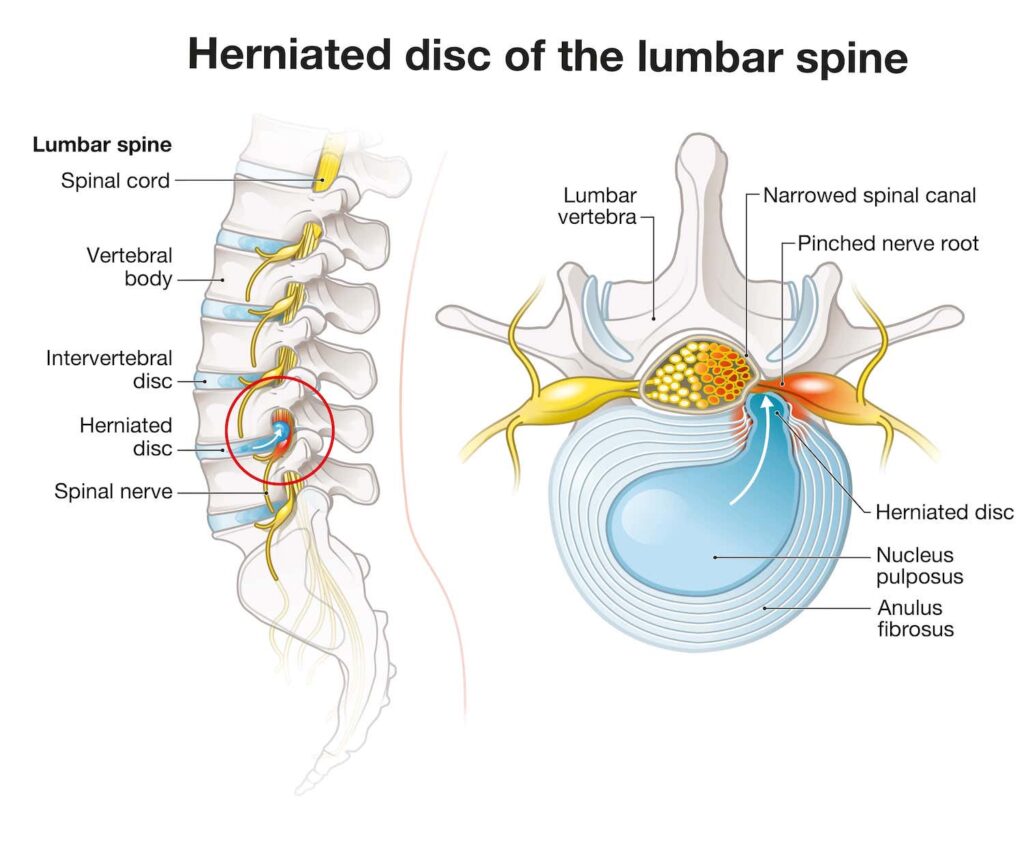
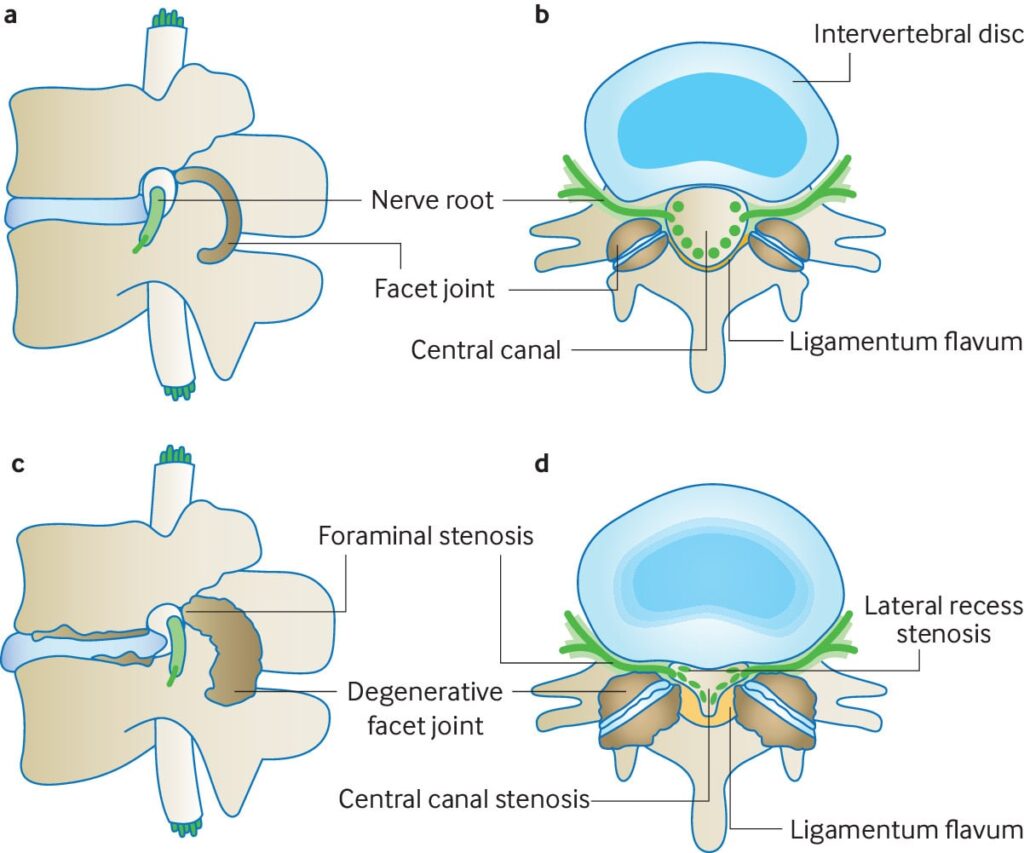
Lumbar spinal stenosis is a progressive wear and tear condition that causes narrowing of the spinal canal and compression of the nerve roots. This can also cause low back pain and sciatica similar to a herniated disc or it may result in symptoms that develop on walking and are relieved by rest. People often describe sensations of pain/numbness/weakness in the legs after walking a certain distance that is relieved once they rest. Over time the symptoms can gradually worsen.
Lumbar spinal stenosis is a condition that develops over many years and is hence more common in older people. It is often due to a combination of a bulging disc, ligament thickening and hypertrophy (overgrowth) of the joints between the lumbar vertebrae (facet joints). Herniated lumbar discs tend to occur in younger people.
This is a condition where one of the lumbar vertebrae slips out of line with the vertebra below it and can cause compression of the spinal nerve roots also. There are a number of different causes of spondylolisthesis, but one of the most common is degenerative spondylolisthesis (due to progressive wear and tear). It is usually associated with lumbar spinal stenosis and can indicate instability in the spine. The symptoms are often similar to those of lumbar spinal stenosis, although back pain can be more common if there is instability in the spine.
Osteoarthritis in the spine can lead to the formation of bone spurs and this can also result in compression of the spinal nerve roots and result in sciatica.
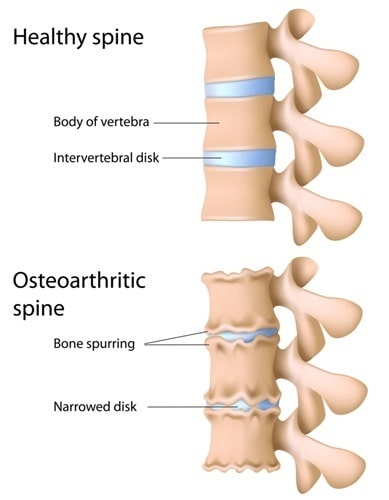
Sciatica can happen suddenly or gradually, depending on the underlying condition. For example, a herniated disc can cause sudden pain, but arthritic pain tends to occur and worsen over time. Nonetheless, some of the common symptoms include:
The pain of sciatica may be worsened in specific postures such as sitting or trying to stand up, twisting the spine or bending forward. Some form of relief is often achieved with gentle walking or lying down.
Sciatica is more prevalent in people whose occupations involve heavy lifting, prolonged sitting or prolonged periods of leaning over. It is important to maintain good posture when sitting, standing, squatting down, and carrying and lifting heavy objects. Regular exercise, weight control and cessation of smoking are all important.
In patients with sciatica there may not be a need for specialised investigations if the symptoms are mild or where the symptoms are improving rapidly. In cases with more severe symptoms or where there is no improvement in the symptoms over time an MRI scan can be useful to detect the underlying cause of the problem and guide the sciatica treatment.
Certain symptoms or patients with certain underlying conditions would need more urgent assessment and diagnosis. This includes the development of any weakness in the leg(s) or any difficulty with bowel or bladder control or patients with a history of trauma, fever, loss of weight, loss of appetite, history of cancer or those who are immunosuppressed.
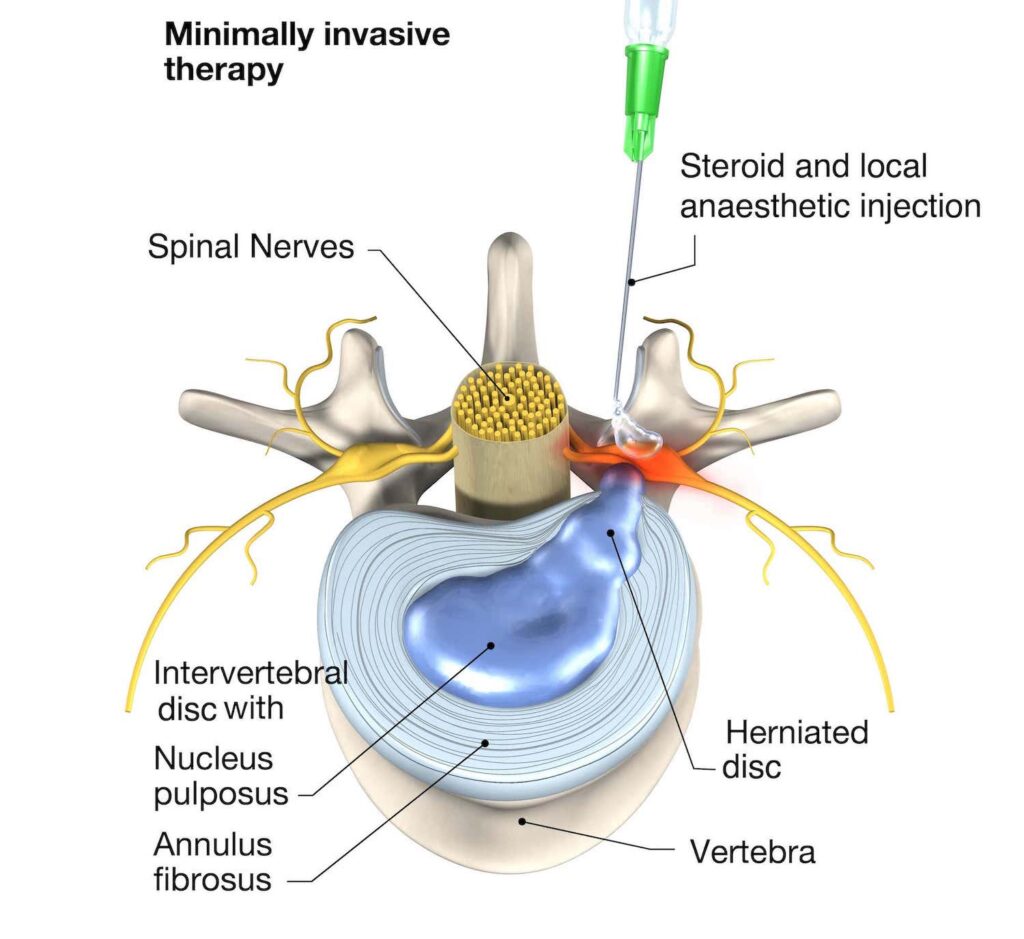
The mainstay of the sciatica treatment in Singapore is usually a combination of medication for symptom control and physiotherapy. A physiotherapist can design a rehabilitation programme to correct posture, strengthen the back muscles and improve flexibility.
In certain conditions, spinal injections can be performed to relieve pain. This would typically be a nerve block with local anaesthetic and steroid medication.
Other procedures include blocking the pain impulses from the discs or joints between the bones in the spine or procedures to shrink disc bulges.
Most patients get better within 4 to 8 weeks with the earlier measures. However, if the symptoms are very severe or do not improve over time, surgery may be recommended. Surgery is also often recommended where there is weakness or disturbance of bowel or bladder function. The aim of surgery is to address the cause of the nerve compression and relieve the pressure on the nerves. This is often achieved using minimally invasive techniques with faster recovery.
Dr Colum Nolan clinical interests include degenerative and complex spinal disorders, cervical spine surgery, spinal tumours, spinal trauma, and endoscopy. He has particular expertise in minimally invasive spine surgery and the use of spinal navigation technology.
Prior to his private practice, he served as the Head of Service and Senior Consultant Neurosurgeon at the National Neuroscience Institute (NNI). He was also the Director of the Spine and Spinal Disorders Programme at NNI and was the head of Neurosurgery Service at Sengkang General Hospital.
No issue is too small.
Reach out to our friendly team.
No issue is too small.
Reach out to our friendly team.
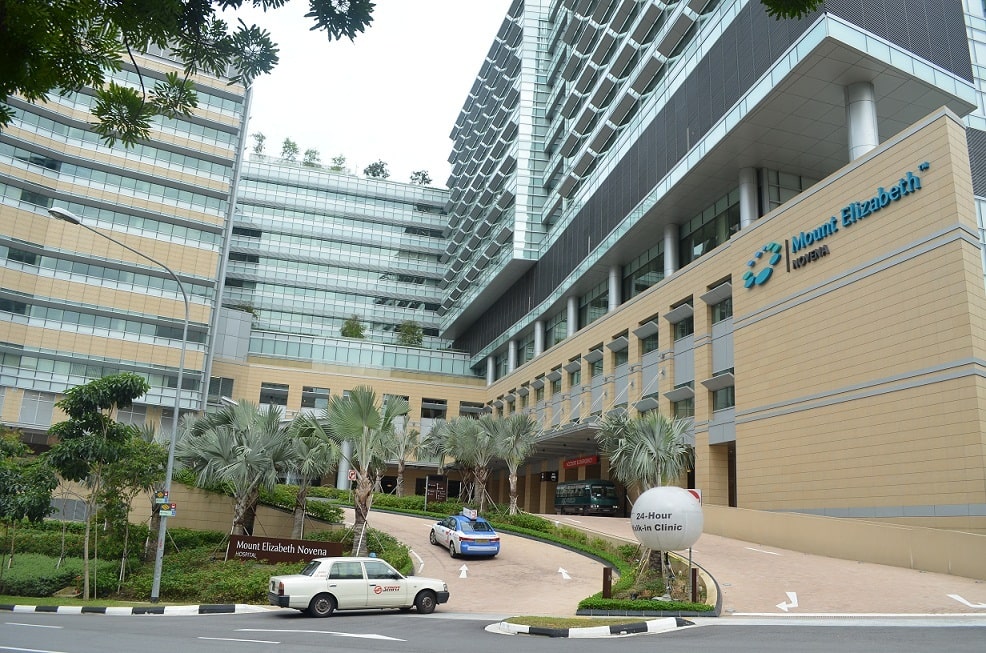
No issue is too small.
Reach out to our friendly team.
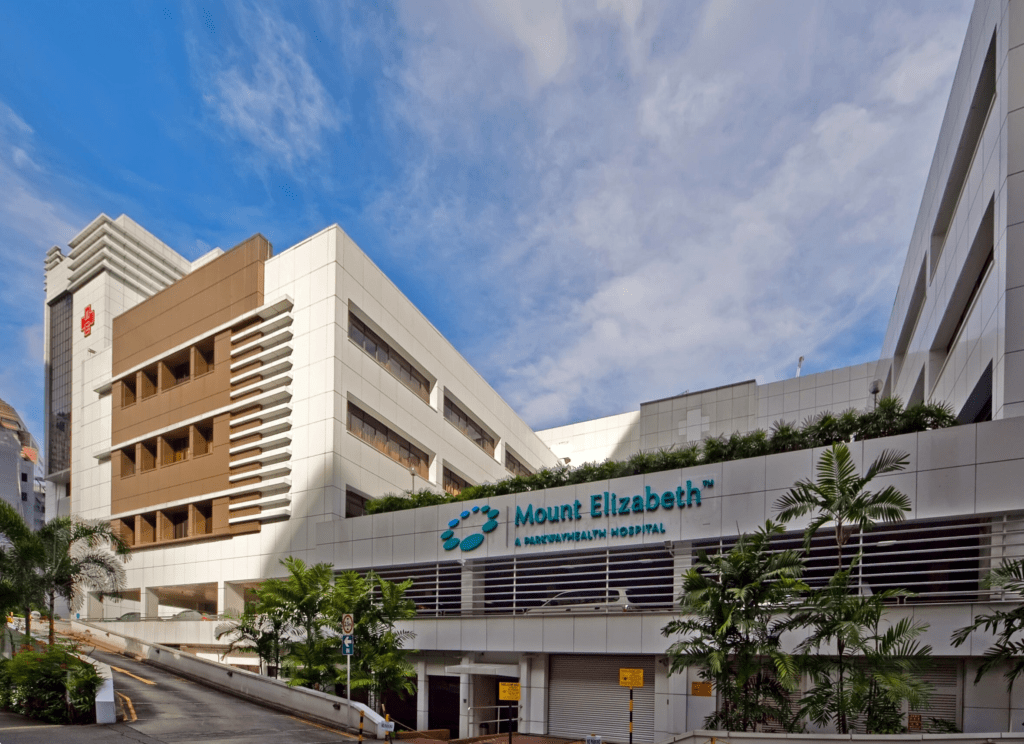
No issue is too small.
Reach out to our friendly team.
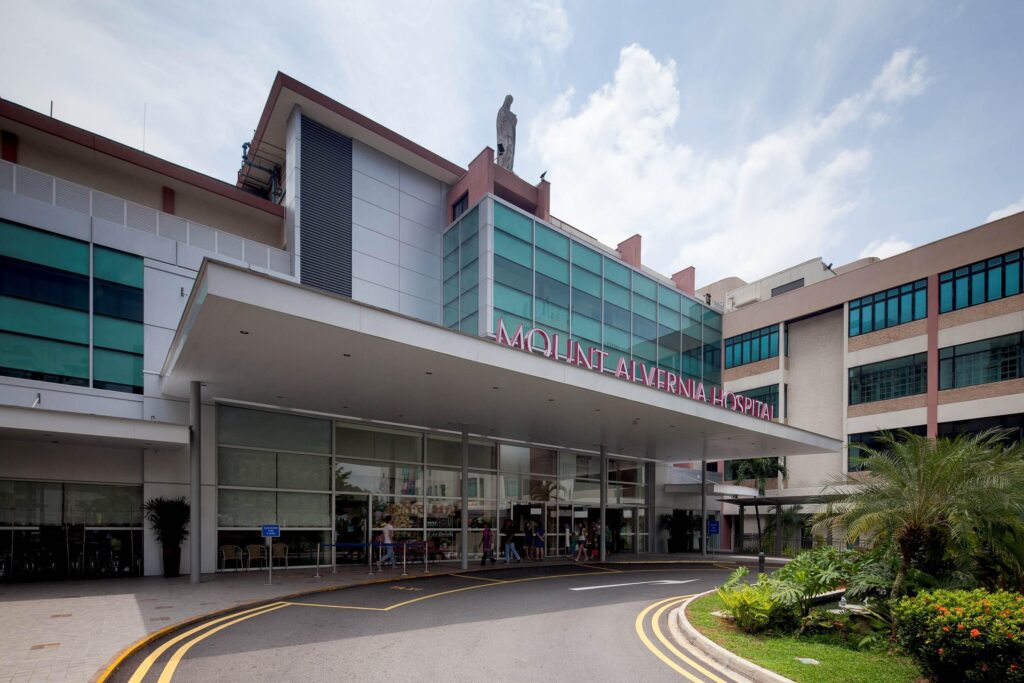
No issue is too small.
Reach out to our friendly team.

No issue is too small.
Reach out to our friendly team.
© 2023 All Rights Reserved | Oxford Spine & Neuro | Terms & Conditions